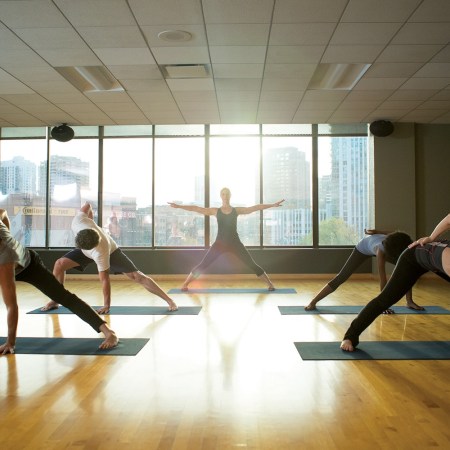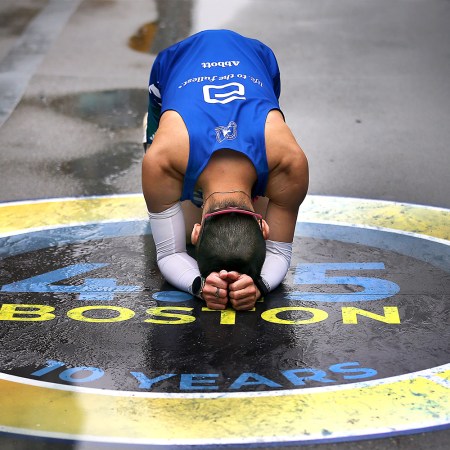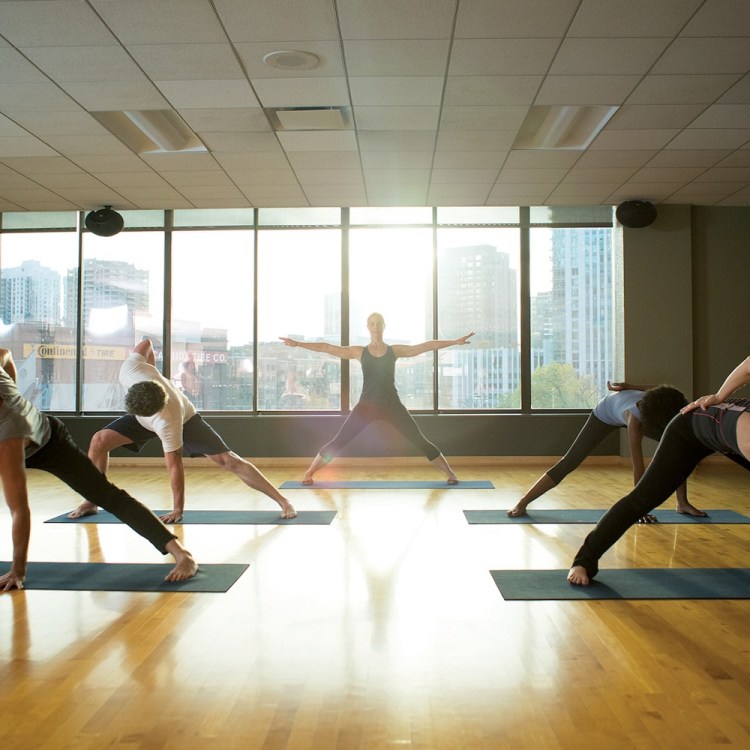Welcome to The Workout From Home Diaries. Throughout our national self-isolation period, we’ll be sharing single-exercise deep dives, offbeat belly-busters and general get-off-the-couch inspiration that doesn’t require a visit to your (now-shuttered) local gym.
A couple months ago, I spent a now science fiction-sounding Thursday evening at Manhattan’s East River Park Track with 45 strangers. Locals call it the Sixth Street Track. The complex sits between FDR Drive and the East River, and it’s a regulation 400 meters, but it doesn’t have lights. Once the sun goes down, runners rely on the inventive coaches who bring floodlights and reflective cones, the twinkle of the Williamsburg Bridge, flashing ferryboats that look like toys, and the Empire State Building’s color scheme, which can be caught, for a second, at the 150 meter mark.
The first time I joined Mile High Run Club for a track workout at Sixth Street, I felt like an ex-pat who’d returned after years spent across the pond — sipping espressos in piazzas, writing never-to-be-published novels, getting used to getting my heart broken. Until this year, I’d spent nearly a decade away from running, chasing gains, flexibility and everything else, but there were reasons that I returned home, and the track not only didn’t disappoint, it delighted. I’d missed the way opposing clubs — in this case, a neighborhood gang called the Dashing Whippets — would rudely, drunkenly scream “TRACK!” while careening down the straight, as if a sailor had fallen into the sea. I missed the nervous twitching, the watch-setting, the practice heroes (if your shoe comes off on a 400, and you’re an adult, you really don’t have to show us you can finish), and even the dry-heaving, all that painful camaraderie that can’t be replicated with ClassPass.
There was one ritual, though, eagerly skipped into by the rest of the runners, that threw me for a loop. It wasn’t that I didn’t know what it was — I just needed a moment to pause, to accept that while I was gone, this had become an expected, agreed-upon norm. The coaches led us into the middle of the spongey green grass, backpedaled to the halfway hash, and promptly led us through an extensive series of dynamic stretches. Lunges, skips, bounds, even 75%-effort straights. It took a while, almost 10 minutes, and when it was over there was no static stretching, but only a minute to toss our quarter-zips into one big pile (these were different times, you have to understand), divide into pacing groups, and head onto the track for mile repeats. My group split 6:10, 6:00 and 5:55.
When I was in high school, studies arrived that favored dynamic stretching over static stretching for runners’ warm-up routines. In 2011, research published in the Journal of Strength and Conditioning explained that dynamic stretching not only decreases the risk of injury, but a static stretching warm-up routine even negatively affects athletic performance. The professional and prep worlds reacted in their own ways to the findings, which, of course, challenged decades of conventional wisdom.
Ahead-of-the-curve outlets like the Olympic Training Center and the Nike Oregon Project, which don’t wait for external scientific studies in order to act out a wellness hunch, simply continued what they were doing. But at the far less official level, I can’t remember any coaches (who, more often than not, are also tenured teachers — who, more often than not, are stubborn as hell) instituting a standardized dynamic stretching routine at the time. That’s not to say people were against it; it just wasn’t what people did yet. I can say with certainty that static stretching before a run or race was still a regular practice just seven years ago, even among America’s elite prep runners.
Times have changed, clearly, and along with it traditions and training. But widespread dissemination on tricks of the trade can sometimes have a trickle-down effect. High school coaches may now, finally, be well equipped to keep young runners’ legs healthy and primed for a PR — but what about the casual jogger? What about someone like me, or all the other prodigal sons and daughters, returned from their dumbbell sabbaticals, eager to hit tracks and trails again? What of all these pandemic-born runners, who’ve taken to the streets in masses in recent weeks, searching for a sweat and fresh air? For all the above, it’s important to know how to warm-up and cool-down properly. Running is simply too beneficial to the body and soul to prepare for incorrectly.
A primer, then. Dynamic stretching should be prioritized before running because it’s a more functional way of preparing for the task at hand. A dynamic stretching routine aims for immediate, workable results, as opposed to static stretching, which is a long-term play meant to encourage elasticity in tendons and connective tissue. Dynamic stretching takes the muscles through their full range of motion. It warms up the body, stimulating both the musculature used for running, and warning the heart that it’s about to be put through the ringer. It’s full-body, too; we talk a lot these days about “full-body fitness,” about functional, holistic moves or training points that engage the whole body. Well, dynamic stretching, as noted by physical therapist John Fiore, is an inherently full-body enterprise, which readies “the hips, quadriceps, hamstrings, gluteals, gastroc-soleus, intrinsic foot musculature, and upper body-torso” over the course of a routine.
By contrast, as the Cleveland Clinic points out, static stretching doesn’t make much sense before putting in miles. It doesn’t even really pass the eyeball-test, when you think about it. Sitting or laying on the ground, slowly pushing legs out or across your chest … none of it has much in common with the demands that begin at the starting line. That doesn’t mean, however, that stretching is dumb and should be forgotten forever. Flexibility is hyper-important, especially in a sedentary society, and holding an elongated muscle in a fixed position for 30 seconds to a minute (without bouncing!) is a great thing to add to the habit tracker. Just, save save it for after the run, when the muscles are warm, or at the end of the day, when coming out of a long shower. Pre-run sit-and-reaches can’t prevent injuries to the knees or Achilles, but they can literally inhibit the body’s performance capacity. The National Strength and Conditioning Association even reports that static stretching “decreases force production, power output, running speed, movement time and muscular endurance.”
So, how exactly should one warm up? Run for five minutes at 50% then begin dynamic stretching. Ideally you’ll have a good chunk of space at your disposal (20 yards or more) and some kind of wall or fence. Practice repeats similar to what the Mile High Run Club ran me through at the beginning of the year. That includes lunges and knee hugs without breaking a slow, concerted stride, high-knee bounds, butt-kicks (pretty self explanatory), Carioca, and the inch worm. This Western Wisconsin care provider, of all places (god bless the internet), has a great collection of moves, with a diagram for each. Remember to keep moving while performing any of these, and to complete them through the line, just without putting in too much effort. The idea is to engage and activate the neuromuscular system, to prepare the body for all the movement that’s happening not long after.
Along the wall, meanwhile, practice swings. South Carolina’s Furman Institute of Running and Scientific Training, which is run by exercise scientists/lifelong runners, has the hook-up. Think straight-leg lateral swings, bent-knee lateral swings, and bent-knee forward swings. The first moves the leg across the body, the second alternates pushing it towards each shoulder, and the final pushes it away from the chest, like the knee-pumping stride of a sprinter. If that’s all too complicated, just hold onto the fence and run purposely in place; remember holding onto the edge of the pool as a kid during swimming lessons, kicking up a water storm behind you? Before the lesson began, the idea was to become accustomed to movements in the water. It’s the same concept here. Running can be an enchanting, addictive thing — at 6th Street, making friends, or completely alone, just keeping sane — but in order to keep at it, to get that CVS receipt-length list of benefits for the mood, mind and the body’s internal organs, we have to prepare properly. And that means getting off the ground.
Whether you’re looking to get into shape, or just get out of a funk, The Charge has got you covered. Sign up for our new wellness newsletter today.
























